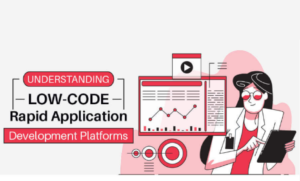
The Benefits of Low Code – No Code Development Platforms for Businesses
Low Code and No Code platforms have been gaining significant traction and airtime recently especially with


Psssst – Have you heard about the Low Code – No Code Phenomenon
Maybe you have already heard about what many are calling the democratisation of software development (ie), empowering ordinary users to build their own software solutions without the need to hire expensive programmers or the need to write ‘Any Code’ in some cases or ‘Limited Amounts of Code’ in others. And if this is in fact true, then why should businesses of all sizes across the globe be sitting up and taking notice.
The Low Code market was valued at $13.3 billion in 2019 and is predicted to grow to a value of $45.5billion by 2025. In this article we will look at some of the drivers for this growth and the opportunities offered by these platforms to level the playing fields allowing smaller companies, even start-ups to catchup, compete or even overtake much larger enterprises.
You might ask why any organisation would want its ordinary people to start developing software solutions at all. I mean, is that not the job of the IT department.
In theory, yes it is, but the problem is that many of the demands within organisations for solutions to the myriad of problems that users encounter on a daily basis are ignored or are deprioritised because of other more important projects that take precedence. IT departments just cannot cope with the demands for solutions fast enough so would it not be hugely beneficial if these users could be provided with the tools to build their own applications to meet these demands themselves.
So let’s start off by explaining what these ‘Low-Code’ – ‘No-Code’ platforms are and how they can enable ordinary users to build sophisticated web and mobile applications without ever having any previous knowledge or experience in software development.
No-code development platforms allow almost any user to create sophisticated application software, either web portals or mobile applications using graphical user interfaces and configurations without the need for any coding instead of traditional computer programming. These platforms are closely related to low-code development platforms as the objective for both is to expedite the application development process. However, no-code development should not be confused with low-code development as these platforms still require some amount of coding and coding skills.
Low-code development platforms on the other hand, provides a hybrid development environment for application development that also employs both a graphical user interface and configuration but still requires some amount of coding and coding skills. . The significant difference with these platforms is that developers of varied experience levels can contribute their own creative flair by writing and developing coded features that seamlessly integrate and enhance the applications developed.
The introduction of both these platform types means that a wider range of people can contribute to application development, not only those with formal programming skills which lowers the initial cost of setup, training, deployment and ongoing maintenance. Both these development platforms reduce the amount of traditional hand coding required which results in accelerated delivery of business applications.
The benefits of these types of platforms to an organisation can be wide ranging and I have explained some of these in more detail below.
It is estimated that No-Code/Low-Code platforms can speed up the development process by as much as ten times when compared to conventional coding methods. With traditional methods, app development can take several months whereas the same product can be built within a few days or weeks using low-code/no-code platforms. Faster development means that product prototypes can be developed faster, revised, refined, tested and ultimately can be released to market much quicker. Additionally, updates can also be made more frequently as anyone trained in using these platforms can make changes regardless of their level of coding knowledge.
No-Code/Low-Code platforms are also ideal for enabling businesses to become more agile and competitive. Because they enable rapid application development, business users can now be invited to participate directly in the prototyping process where the applications are created and iterated in real time directly with these end users. This can save significant time and energy in the requirements and design phase, and ensures that the business gets the requirements exactly right.
By nature, no-code/low-code platforms democratises the development process by empowering employees outside traditional IT teams to have direct input into the application development process. Productivity increases as anybody within the organisation is able to contribute to the project, no matter what their IT skill level. This is made possible as these platforms provide visual development tools, usually in the form of drag-and-drop interfaces, which makes it possible to build applications without the need to write any code. Pre-built features are also available that can be used to construct even sophisticated applications without input from developers at any stage.
No-code/Low-code platforms are ideal for developing an MVP and is an incredibly efficient method for any business owners who want to develop a business application. An MVP is basically a prototype of your desired application, with all the most important features and functionalities included within the design. This enables the business to test their application on real users to measure the engagement and verify that the initial objectives have been met. This allows the business to manage the development process iteratively allowing them to add more advanced features once they are confident that the application has met the required expectations.
Skilled programming resources can be hard to find and their time and efforts are expensive whereas no-code platforms ensures quick development, saving the time and money spent by and on these resources. No-code/Low-code platforms come with a wealth of features already prebuilt and tested for use within your applications. This significantly reduces the risks to an organisation as coding bugs, project delays and project creep are all eliminated. The resulting efficiencies experienced by the business also ensures a high Return on Investment (ROI).
Applications developed through traditional coding methods are typically built for one platform or another, either Android or iOS mainly due to the costs associated with developing for two very different platforms. For each platform you will generally require separate skilled resources, covering Web Portal, Web Services, Android and iOS platforms. However, many no-code/low-code development platforms are cross-platform compatible enabling a single resource within the business to develop applications once and deploy them instantly across multiple platforms and associated devices at the same time.
As no-code/low-code platforms remove the need for writing code, businesses now don’t have to worry about underlying security protocols either, such as encryption and patching your software. Security is managed by these systems seamlessly under the hood providing you with an end product that is secure, robust, scalable and that’s fit for purpose. These platforms can also work in close concert with IT, allowing for integration with core Active Directory environments and offering Single Sign-On and 2 Factor authentication.
According to a recent survey, the average salary for a senior software developer in Ireland is almost 70k and thats without taking healthcare, pensions or employers contributions into account. No-code/Low-code platforms drastically reduce the time and efforts required to develop applications resulting in lower cost of ownership. This is a highly cost-effective substitute for employing or outsourcing application development to highly skilled and expensive resources and enables businesses to reduce the burden on their IT teams, enabling them to remain competitive and keep up with the demands for digital innovation. The cost of a high-quality no-code/low-code platform is substantially lower than the monthly salary of a single software developer.
ERS IT Solutions have been developing robust software applications for over 20 years and have an impeccable reputation for delivering successful projects on time and on budget. Our newly released Team Konnect Enterprise rapid application development platform is one of the new generation of NO-CODE platforms that enables businesses to create business applications for both web and mobile platforms in days instead of months all without the need for writing any code.
Why not contact us today for a demonstration and see how Team Konnect Enterprise can dramatically increase the successful delivery of your software development projects.
To learn more about how your business can benefit from our Team Konnect Rapid Application Development Platform contact us by email @ demo@teamkonnect.com for a demonstration or call +3531-8859500 and ask for a member of the Team Konnect team.

Low Code and No Code platforms have been gaining significant traction and airtime recently especially with

No Code Platform Considerations As our business environments become ever more complex and peoples time

Overview Software applications are essential instruments for every modern business today. Companies rely on software

Low code rapid application development platforms are really gaining traction in the market today. With

Scan across the globe today and you will find millions of different business processes in

Data collection is required across every facet of life today within almost every business in
00-3531-8859500
01-8859500
00-3531-8859501
Unit 5, Block 8, Blanchardstown Corporate Park Dublin 15, D15 V240, Ireland
© 2021 TeamKonnect. All rights reserved